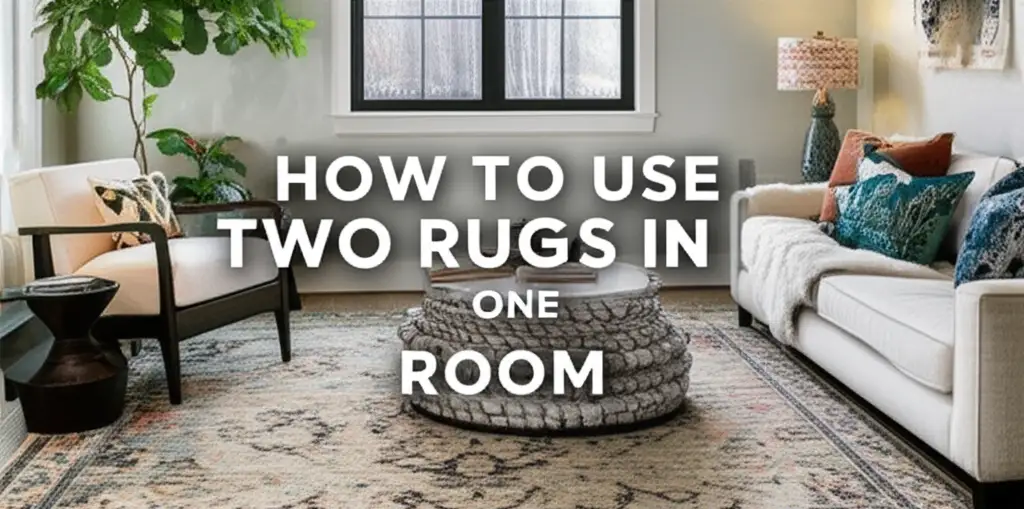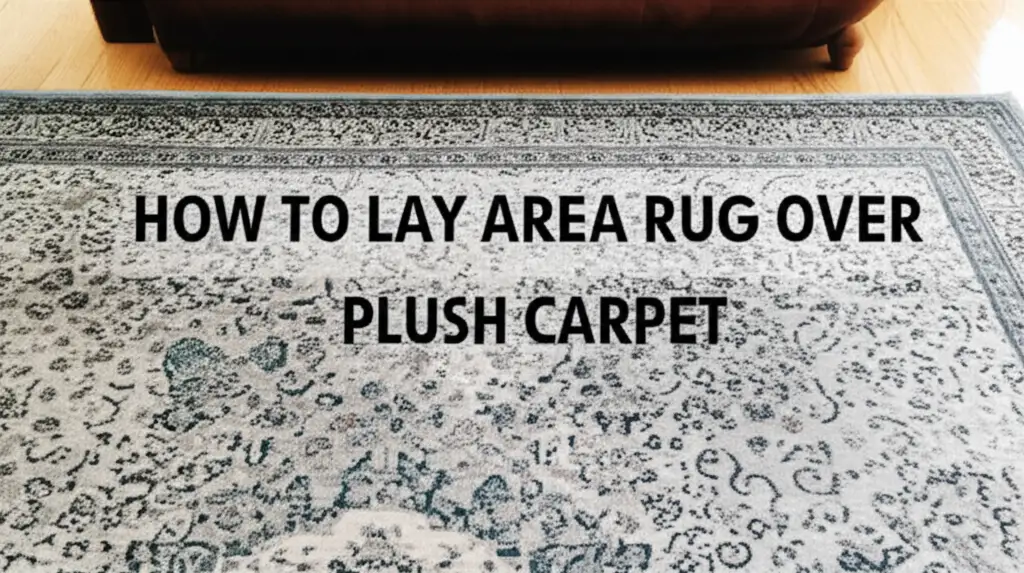· Mason Everett · Home Decor · 14 min read
How To Use Two Rugs In One Room

Mastering the Art of Two Rugs in One Room
Have you ever looked at a room and felt it needed something extra? Perhaps it felt too large, or lacked definition. Using two rugs in one room can transform your space. This approach adds warmth, texture, and visual interest. It also helps to define different areas within a single large room. In this article, we will explore the many benefits of incorporating multiple rugs. We will also cover how to choose the right rugs and place them effectively. Get ready to create a home that feels both stylish and cohesive.
Takeaway:
- Two rugs create distinct zones in large rooms.
- Layering rugs adds depth and visual interest.
- Choose rugs that complement each other in style and color.
- Consider size and placement to ensure harmony.
- Proper maintenance keeps your dual rug setup beautiful.
How To Use Two Rugs In One Room: A Quick Guide
You can use two rugs in one room by layering them or placing them side-by-side. Layering involves putting a smaller rug on top of a larger one, adding depth and warmth. Side-by-side placement helps define different functional zones, making a large room feel more organized and purposeful.
Why Use Two Rugs in One Room? Discovering the Benefits
Using more than one rug in a single space offers many advantages. It goes beyond simple decoration. This design choice brings both aesthetic appeal and practical benefits to your home. I have seen how this simple change can make a huge difference in a room’s feel.
One major benefit is defining distinct zones. In open-concept homes, areas can blend together. Two rugs clearly mark a living space separate from a dining area. This creates a sense of order and purpose. Each zone feels like its own room, even without walls.
Another advantage is adding warmth and texture. Rugs make hard floors softer underfoot. They also absorb sound, making the room quieter. Layering rugs especially brings rich texture. It makes the floor a focal point.
A third benefit involves visual interest and depth. A single rug can sometimes look flat. Two rugs, especially layered ones, create dynamic visuals. They add layers of color, pattern, and material. This makes the room feel richer and more complex.
Finally, using two rugs can protect your flooring. They act as barriers against wear and tear. High-traffic areas benefit most from this protection. Rugs also hide imperfections on the floor. This provides a fresh look without needing major renovations.
Choosing Your Rugs: Harmony, Contrast, and Size
Selecting the right rugs is crucial for success. You need to think about how they will interact. Consider color, pattern, texture, and size for each rug. My goal is always to create a cohesive look.
First, let us talk about color and pattern. You can choose rugs that match perfectly. Or, you can select rugs that offer a pleasing contrast. A neutral base rug with a colorful top rug works well for layering. For side-by-side placement, rugs with similar color palettes create flow. Bold patterns should be balanced with simpler ones. This prevents the room from feeling too busy.
Next, consider texture. Different textures add depth. A fluffy shag rug layered over a flat-weave jute rug creates interest. Smooth, soft rugs can be paired with rougher, natural fiber rugs. These contrasts make the room feel more inviting. They encourage you to explore the space.
Finally, rug size and shape are vital. For layering, the bottom rug must be significantly larger than the top one. This allows the base rug to frame the top rug. It ensures both rugs are visible. When placing rugs side-by-side, make sure they are proportionate to their respective zones. They should not overlap or crowd the space. You can find more insights on choosing the right rug size for your room. Proper sizing ensures your design looks intentional.
Think about the overall style of your room. Are you going for a modern look, or something more traditional? Your rug choices should reflect this. The rugs should enhance the existing decor. They should not fight against it.
Strategic Placement: Defining Zones with Rugs
Effective placement makes two rugs work in harmony. The way you arrange them creates distinct areas. This helps a large room feel functional and welcoming. I often suggest thinking of your room as having multiple small rooms within it.
One common strategy is creating a conversation area. In a large living room, one rug can anchor the main seating arrangement. This might include a sofa and armchairs. A second, smaller rug can define a separate reading nook. This second area might have just an armchair and a side table. This setup clearly marks two different functional spaces.
Another approach is to divide a living-dining space. An open-concept area often includes both. Use one large rug under the dining table and chairs. Ensure the chairs remain on the rug even when pulled out. Place another rug in the adjacent living area. This rug should be large enough to contain the main seating group. This method clearly separates eating from relaxing.
For bedrooms, you might use two rugs differently. A large rug can sit under the bed, extending out on all sides. This anchors the sleeping area. A smaller, plush rug can be placed beside the bed. This creates a soft landing for your feet in the morning. Or, two identical smaller rugs can flank the bed on each side. This creates symmetry and comfort.
Remember the flow of traffic in the room. Rugs should not impede movement. They should guide people through the space. Ensure enough floor space remains visible around the rugs. This prevents the room from feeling cramped. The way you arrange your rugs can impact the overall feel. It is similar to how the direction of a carpet pattern can influence a room’s perception.
Layering Rugs: A Popular Approach for Depth
Layering rugs is a highly popular design trend. It adds significant depth and visual interest to any room. This technique involves placing a smaller rug on top of a larger one. I love how it creates a cozy, inviting atmosphere.
To begin layering, choose a large base rug. This rug acts as your foundation. It should cover a substantial portion of the floor. Often, it anchors a furniture grouping, like a living room sofa and chairs. Neutral colors or simple patterns work best for the base rug. Think natural fibers like jute, sisal, or a large, simple wool rug. This base sets the stage without overwhelming the space.
Next, select your top rug. This rug is typically smaller and more decorative. It can feature bold colors, intricate patterns, or unique textures. Place this top rug on the base rug, centered within a key area. For instance, in a living room, place it under the coffee table. Ensure enough of the base rug shows around the edges. This frames the top rug beautifully.
Consider the interplay of textures. A rough, natural fiber base rug pairs wonderfully with a soft, plush top rug. This contrast makes the layered effect more dramatic. It also makes the area feel more luxurious underfoot. You can also experiment with different shapes. A round rug on top of a rectangular one adds a playful touch.
Layering also offers practical benefits. It provides extra cushioning and warmth. It can also help to protect a more expensive or delicate top rug from direct wear. Make sure both rugs lie flat to prevent tripping hazards. Use a non-slip pad under the base rug. You might also consider a thinner pad between the two layers for extra stability. This ensures your layered look is both stylish and safe.
Side-by-Side Placement: Creating Visual Flow
Placing rugs side-by-side is another effective way to use two rugs in one room. This method is excellent for defining separate areas in a large or open space. It creates a sense of visual flow and purpose. I find this especially useful in long, narrow rooms or open-concept layouts.
When placing rugs side-by-side, consider their relationship. They do not need to be identical. However, they should share some common element. This could be a similar color palette, a consistent texture, or a complementary style. This commonality ensures the room feels cohesive. It prevents the space from looking disjointed.
One common scenario for side-by-side placement is a combined living and dining area. You might place a large area rug under the dining table. This clearly marks the dining zone. Adjacent to it, another large rug defines the living room seating area. Ensure there is a clear walkway between the two rugs. This maintains separate functions while allowing easy movement. The space between the rugs becomes a natural path.
In a very long room, you can use two rugs to break up the length. Place one rug at each end of the room. Each rug anchors a distinct activity zone. For example, one end could be a main seating area. The other end could host a desk and office chair, or a small play area. This prevents the room from feeling like a bowling alley. It creates more intimate spaces within the larger room.
Ensure the rugs are proportionate to their respective zones. They should be large enough to hold the main furniture pieces in each area. For instance, all front legs of a sofa and chairs should ideally rest on the rug. Avoid small, “floating” rugs that do not connect to furniture. This makes the arrangement look accidental rather than intentional. Consider the overall balance. Both rugs should contribute to a harmonious look, even when distinct.
Common Mistakes to Avoid When Using Two Rugs
Using two rugs effectively requires careful planning. Many common pitfalls can make your space look cluttered instead of curated. I have seen these mistakes often. Avoiding them ensures your multi-rug setup enhances your home.
One major mistake is choosing the wrong rug sizes. Two small rugs can make a large room feel even more disjointed. They might appear to “float” aimlessly. Conversely, two rugs that are too large can make a room feel cramped. They might leave little visible floor space. Always measure your areas carefully before buying. Ensure each rug is proportionate to its zone.
Another error is clashing styles or colors. While contrast is good, complete discord is not. If your rugs have wildly different aesthetics, they will fight for attention. The result is a chaotic look. Aim for complementary patterns, colors, or textures. They should speak to each other, even if they are not twins.
Poor placement is also a common issue. Placing rugs without thought to furniture arrangement or traffic flow creates problems. Rugs should anchor furniture. They should define paths. Do not place rugs where they block doorways. Do not put them where they make walking difficult. The arrangement should feel natural and intuitive.
Ignoring maintenance is another pitfall. Two rugs mean double the cleaning effort. If one rug looks dirty while the other is spotless, the whole room suffers. Regular cleaning, vacuuming, and spot treatment are essential. You can learn more about whether you should only vacuum rugs for best practices. Neglecting one rug can detract from the beauty of both.
Finally, failing to secure rugs is a safety hazard. Unsecured rugs can slip. This leads to falls. Always use non-slip rug pads. This is especially important for layered rugs. A non-slip pad under the bottom rug keeps it in place. A thin pad between layers can also prevent the top rug from shifting. Safety should always come first in your home design.
Maintaining Your Dual Rugs for Lasting Beauty
Once you have perfected your two-rug setup, proper maintenance becomes key. Keeping both rugs clean and well-preserved ensures their longevity. It also maintains the aesthetic appeal of your room. I always tell my clients that maintenance is as important as the initial setup.
Regular vacuuming is essential for both rugs. Dirt and dust can settle deep into fibers. This causes wear over time. Vacuum both rugs frequently, especially in high-traffic areas. For layered rugs, you might need to lift the top rug to clean the base rug thoroughly. Adjust your vacuum settings for different rug types. Some delicate rugs may require a gentler approach.
Address spills and stains immediately. The longer a spill sits, the harder it is to remove. Blot spills gently with a clean cloth. Avoid rubbing, as this can spread the stain. Use appropriate cleaning solutions for the rug material. Always test cleaners on an inconspicuous area first. Different materials require different care. For example, removing moths from wool rugs requires specific treatments.
Consider professional cleaning periodically. Depending on foot traffic and rug material, your rugs will benefit from deep cleaning. This removes embedded dirt and refreshes the fibers. Follow the manufacturer’s recommendations for professional cleaning frequency. This extends the life of your rugs significantly.
Rotate your rugs occasionally. This helps to distribute wear evenly. If one part of a rug is constantly underfoot or exposed to sunlight, it will show wear faster. Rotating it shifts these pressure points. For layered rugs, you can rotate the top rug separately from the base rug. This small step makes a big difference in maintaining their appearance.
Finally, protect your rugs from excessive sunlight. UV rays can fade colors over time. Use blinds or curtains during peak sunlight hours. This simple measure helps keep your rug colors vibrant. Taking these steps ensures your two-rug arrangement remains a beautiful feature in your home for years.
FAQ Section
Can two rugs be the same size in one room?
Generally, no. Two rugs of the same size in one room can make the space feel unbalanced or repetitive. For layering, the base rug needs to be significantly larger. For side-by-side placement, rugs should be sized appropriately for their distinct zones. This creates a more purposeful and aesthetically pleasing arrangement.
What kind of rugs go well together?
Rugs that go well together often share a common color palette or complementary textures. You can pair a busy pattern with a solid color, or a natural fiber with a plush material. The key is balance; one rug might be the star, while the other provides a supportive backdrop.
How do you arrange two rugs in a living room?
In a living room, you can layer a smaller rug on top of a larger one under the main seating area. Alternatively, place two rugs side-by-side to define separate zones, such as a main sitting area and a reading nook. Ensure both rugs anchor furniture pieces and allow for clear pathways.
Should rugs match the sofa color?
Rugs do not need to perfectly match the sofa color. They should, however, complement the overall color scheme of the room. You can choose a rug that provides a subtle contrast, introduces an accent color, or ties together various existing colors in the space.
Can you put two rugs in an open concept floor plan?
Yes, using two rugs is highly effective in an open-concept floor plan. They are excellent tools for visually dividing the large space into distinct functional zones, such as a living area and a dining area, without using physical barriers. This creates a more organized and defined feel.
What is the purpose of layering rugs?
Layering rugs serves several purposes. It adds warmth, depth, and texture to a room. It also provides an opportunity to combine different patterns and colors. Furthermore, layering can protect the main flooring and make a space feel more inviting and cohesive.
Conclusion
Using two rugs in one room is a powerful design technique. It transforms ordinary spaces into inviting, well-defined areas. From adding warmth to creating visual interest, the benefits are clear. Remember to choose your rugs carefully, considering size, color, and texture. Strategic placement is key to defining zones and creating seamless flow. Whether you opt for layering or side-by-side arrangements, these ideas can elevate your home.
I hope this guide inspires you to experiment with multiple rugs. It is a simple yet effective way to refresh your living space. Consider the impact two rugs can have on your home’s aesthetic and function. Begin your rug journey today and see the difference for yourself.





